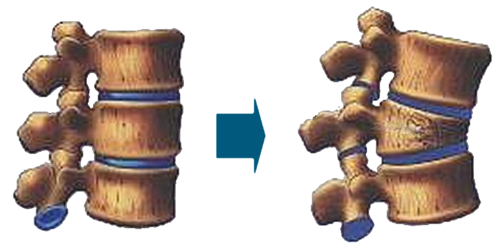Staff members involved in AGING SPINE:
- Dr. ir. Jasper Homminga
- Ir. Edsko Hekman
- Dr. ir. Jeroen Rouwkema
- Prof. dr. ir. Nico Verdonschot
- Prof. dr. ir. Bart Verkerke
Goal
The goals of the AGING SPINE project are; firstly, to understand what causes the frequent occurrence of vertebral fractures in the aging spine, and, secondly, to design prevention methods for such fractures.
This involves computational and in vitro analyses on spines and vertebrae, as well as the design of new methods for the prevention and restoration of fractured vertebrae.
Background
One of the largest problems facing the growing population of elderly people is osteoporosis. Osteoporosis causes a dramatic decrease in bone strength, resulting in large numbers of bone fractures. Vertebral fractures are present in about 25% of all postmenopausal women in the western world, meaning more than 1 million vertebral fractures occurring every year in the EU (40 000 in the Netherlands). The fracture incidence rates for vertebral fractures increase dramatically with age. In European women the incidence rises from 0.36% per year for women 50-54 years to 2.9% for women 75-79 years.
Such a wedge fracture dramatically changes the loading in and on the spine, exposing the vertebrae to higher fractures risks. With our current research we wish to firstly understand what causes the first fracture. Secondly we wish to design prevention methods for such first fractures.

Normal spine and spine with osteoporotic wedge fracture
Apart from the direct problems that osteoporosis causes (fractures), it causes large problems in all spinal afflictions that require posterior fixation, such as hyper kyphosis, hernia, spondylolisthesis or spinal stenosis. The currently available fixation techniques are unsuccessful in these cases because of the reduced fixation strength in osteoporotic bone. These problems are only increased by the current trend away from fusion systems (requiring temporary fixation) and towards non-fusion systems (requiring permanent fixation). As the fixation of fusion systems to the osteoporotic spine is already problematic, the fixation of non-fusion systems is almost certain to fail.

Aged spine with hyperkyphosis before and after treatment with posterior fixation
Currently available fixation systems include wires, hooks and screws. Wires can be wound around or through the lamina, the transverse processi, or the spinous process. Hooks can be attached to the lamina, the pedicle, or the transverse processi. Both wires and hooks are, however, unable to supply a truly rigid fixation to the vertebrae because both techniques are prone to slide over the vertebral surface. The task of primary fixation to the spine is therefore commonly assigned to screws that are placed through the pedicle and into the vertebral body, i.e. pedicle screws. However, fixation in the older and osteoporotic spine is full of complications, such as screw loosening, migration or back-out. Increasing the fixation strength to osteoporotic vertebrae has been attempted by changing the screw geometry (longer, thicker, tapered screws), by using expandable screws, and by cement augmentation. Despite these improvements in screw design, they are not sufficient to realize an adequate fixation to osteoporotic spine. With our current research we wish to develop a fixation technique usable for osteoporotic vertebrae.

Spinal fixations systems: hooks and wires
Progress
2010 | Modeling of age related and postmenopausal bone loss in the human spine | Marleen Ruijter |
2009 | Effects of bone remodeling on the mechanics of the aging spine. | Vera Bulsink |
Anchoring an osteoporotic vertebra | Jean Paul Klein | |
2008 | Development of a validated spine model to assess the mechanics of the degenerated spine. | Christiaan Jansen |
2007 | in vitro experiments on spinal segment | Marieke ter Voert |
Getting involved
Are you a master or bachelor student and would you like to do a research project on the aging spine, please send an email to Jasper Homminga (j.homminga@utwente.nl). We are always on the look-out for good students to help us analyze and solve the problems of the aging spine.
Selected publications
Homminga J.; Aquarius R.; Bulsink V.E.; Jansen C.T.J., Verdonschot N. Intervertebral Disc Degeneration can induce Degenerative Bone Adaptation in Adjacent Vertebrae. submitted, 2010.
Conference Proceedings
Homminga J.; Aquarius R.; Bulsink V.E.; Jansen C.T.J., Verdonschot N. Intervertebral Disc Degeneration can induce Degenerative Bone Adaptation in Adjacent Vertebrae. In: Proceedings of ORS 2010. New Orleans: 2010.
Homminga J.; Aquarius R.; Bulsink V.E.; Jansen C.T.J., Verdonschot N. Intervertebral Disc Degeneration can induce Degenerative Bone Adaptation in Adjacent Vertebrae. In: Proceedings of ESB 2010. Edinburgh: 2010.
Jansen C.T.J., Homminga J., Verdonschot N., Verkerke G.J. Validated Spine Model to Assess Degenerated Spine Mechanics. In: Proceedings of the Dutch BME 2009. Egmond aan Zee: 2009.
Collaborations
Academic
- Applied Mechanics, University of Twente
- Orthopedic Research Lab, University Medical Centre Nijmegen St Radboud
- Biomedical Engineering, University Medical Centre Groningen
- Faculty of Human Movement Science, Vrije Universiteit Amsterdam
